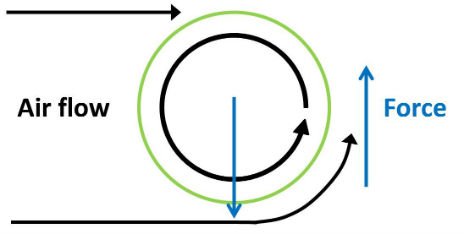Pitch Metrics: Horizontal and Vertical Break
This is a continuation of a series of blog posts written by Dennis Boatman on how Optimum Athletes uses Trackman to accurately understand how our athletes are developing and gives us a better metric datapoint to help optimize their game. For other entries on Pitch Metrics please visit our Blog page here.
One of the major benefits of using the Trackman is that it reads the spin of the ball and generates numbers telling us how much the pitch moved. The science behind how these numbers are created comes from “spin induced movement”, and also called the “Magnus Effect”. For example, the Magnus Effect is the reason why soccer players can bend the ball in different directions by kicking it with a certain spin.
Magnus Effect Visualized
There are other factors that can play into pitch movement, but we will be focusing on “spin induced movement''.
During a bullpen, the Trackman will give us numbers to tell us how much each one of the pitches moved. These numbers will be the horizontal break (side to side movement) and vertical break (up and down movement).
This is the Magnus Effect shown in motion.
Backspin and topspin affect the vertical break, and sidespin affects the horizontal break. These numbers are typically anywhere from negative 25 to positive 25 inches.
Carter Benbrook throwing a sinker with over negative 20 inches of horizontal movement.
Owen Sharts throwing a curveball with over negative 27 inches of vertical break.
Horizontal break (HB) is pretty easy to wrap your head around.
If it has negative 10 HB, the ball moves 10 inches to the left. If it has positive 10 HB, the ball moves 10 inches to the right. On the other hand, vertical break (VB) numbers aren’t quite as simple because gravity is involved.
A ball with zero spin (or a ball with zero vertical break) is going to fall at the rate of gravity, so because of the “Magnus Effect” any backspin or topspin on the baseball will affect how quickly the ball drops. Take a look at this visual.
In the black line, a ball with positive 10 inches of VB still drops with gravity, but at a slower rate. The backspin from the ball is fighting gravity and it arrives at home plate 10 inches higher than the ball with no spin (or zero inches of VB shown in the red line). For pitches with topspin, shown in the blue line, they will have negative VB and they will arrive at home plate lower than the ball with no spin (or zero inches of VB).
As trainers, we look at our athletes’ vertical and horizontal break to determine the strength of their pitches.
Knowing the basics of vertical and horizontal break, we can now dig deeper into what makes a ball have a lot of movement and how we can start to manipulate these numbers. Check out “Spin Efficiency and Spin Direction” coming up next.





